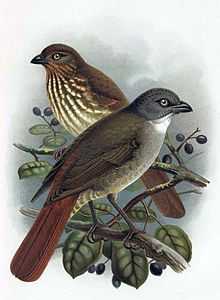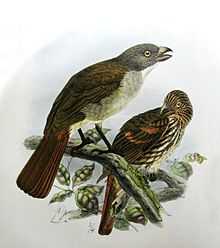Piopio (bird)
| Piopio | |
|---|---|
 | |
| South Island Piopio in front, North Island Piopio at rear. | |
| Conservation status | |
| Extinct (early 20th century) | |
| Scientific classification | |
| Kingdom: | Animalia |
| Phylum: | Chordata |
| Class: | Aves |
| Order: | Passeriformes |
| Suborder: | Passeri |
| Family: | Oriolidae |
| Genus: | Turnagra Lesson, 1837 |
| Species | |
| Synonyms | |
|
Keropia Gray, 1840 | |
The piopios or turnagras comprise a genus of two passerine birds endemic to New Zealand, both of which are now considered extinct. Sometimes described as New Zealand thrushes, the piopios had only a coincidental, passing resemblance to the Thrush family. Piopios have been a longstanding taxonomic mystery. They are often said to have more in common with the bowerbird family of Australia, but differ in terms of nest construction, egg marking, and voice. A relationship has also suggested with the whistlers (Pachycephalidae). The IOC regarded this family as incertae sedis until the question is resolved whether the genus Turnagra belongs to the Ptilonorhynchidae family.[1] The genus was finally placed in the Old World oriole family (Oriolidae), possibly closely related to the figbirds.[2] The specific names of both species were based on mistakes; Turnagra capensis was so named because Anders Sparrman mixed up his specimens and thought the bird had been collected in South Africa (capensis referring to the Cape). The North Island's Turnagra tanagra was so named because it was thought to be related to the tanagers of the Americas.[3]

Little is known about their biology. They frequented the undergrowth and forest floor. Their nests were well constructed cups placed in trees a few metres from the ground, in which two to four eggs were laid. Walter Buller described their calls as being amongst the most beautiful of any New Zealand bird. They were also able to mimic the calls of other birds. They were omnivorous, with records of them hawking for insects over a river, as well as eating spiders, fruit and oats.[3]
Extensive deforestation throughout the country (particularly in the lowlands) and the introduction of mammalian predators, particularly rats, to the North and South Islands in the 19th century during the period of European settlement are believed to have caused the extinctions of both species. The last verified North Island Piopio was shot in 1902, although poorly documented sightings were reported as late as the 1970s. The South Island Piopio was last recorded in 1905. Plans to move birds to predator-free islands were mooted but either never acted on or were derailed due to the lack of suitable sanctuaries.[4]
Species of Turnagridae
- South Island Piopio or New Zealand Thrush, Turnagra capensis
- Stephens Island Piopio, Turnagra capensis minor
- North Island Piopio, Turnagra tanagra
References
- ↑ IOC World Bird List Vol. 2
- ↑ Johansson, Ulf; Eric Pasquet; Martin Irestedt (2011). "The New Zealand Thrush: An Extinct Oriole". PloS One 6 (9). doi:10.1371/journal.pone.0024317. PMC 3170299. PMID 21931679.
- ↑ 3.0 3.1 Worthy, Trevor H.; Richard N. Holdaway (2002). The Lost World of the Moa. Bloomington: Indiana University Press. pp. 424–427. ISBN 0-253-34034-9.
- ↑ Tennyson, A. & Martinson, P. (2006) Extinct Birds of New Zealand Te Papa Press,Wellington ISBN 978-0-909010-21-8
External links
- Piopio
- South Island Piopio. Turnagra capensis. by Paul Martinson. Artwork produced for the book Extinct Birds of New Zealand, by Alan Tennyson, Te Papa Press, Wellington, 2006
- North Island Piopio. Turnagra tanagra. by Paul Martinson. Artwork produced for the book Extinct Birds of New Zealand, by Alan Tennyson, Te Papa Press, Wellington, 2006
| ||||||||||||||||
